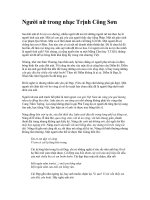con heo đất âm nhạc 2 tạ xuân thuỷ thư viện tư liệu giáo dục
Bạn đang xem bản rút gọn của tài liệu. Xem và tải ngay bản đầy đủ của tài liệu tại đây (28.53 KB, 8 trang )
<span class='text_page_counter'>(1)</span><div class='page_container' data-page=1>
Questions 1-9
The ocean bottom ---- a region nearly 2.5 times greater than the total land area of the
Earth ---- is a vast frontier that even today is largely unexplored and uncharted. Until
about a century ago, the deep-ocean floor was completely inaccessible, hidden beneath
waters averaging over 3,600 meters deep. Totally without light and subjected to intense
(5) pressures hundreds of times greater than at the Earth's surface, the deep-ocean bottom
is a hostile environment to humans, in some ways as forbidding and remote as the void
of outer space.
Although researchers have taken samples of deep-ocean rocks and sediments for
over a century, the first detailed global investigation of the ocean bottom did not
(10) actually start until 1968, with the beginning of the National Science Foundation's
Deep
Sea Drilling Project (DSDP). Using techniques first developed for the offshore oil and
gas industry. the DSDP's drill ship, the Glomar Challenger, was able to maintain a
steady position on the ocean's surface and drill in very deep waters, extracting samples
of sediments and rock from the ocean floor.
(15) The Glomar Challenger completed 96 voyages in a 15-year research program that
ended in November 1983. During this time, the vessel logged 600,000 kilometers and
took almost 20,000 core samples of seabed sediments and rocks at 624 drilling sites
around the world. The Glomar Challenger's core samples have allowed geologists
to reconstruct what the planet looked like hundreds of millions of years ago and to
(20) calculate what it will probably look like millions of years in the future. Today,
largely
on the strength of evidence gathered during the Glomar Challenger's voyages, nearly
all earth scientists agree on the theories of plate tectonics and continental drift that
explain many of the geological processes that shape the Earth.
The cores of sediment drilled by the Glomar Challenger have also yielded
(25) information critical to understanding the world's past climates. Deep-ocean
sediments
provide a climatic record stretching back hundreds of millions of years, because they
are largely isolated from the mechanical erosion and the intense chemical and biological
activity that rapidly destroy much land-based evidence of past climates. This record has
already provided insights into the patterns and causes of past climatic change---
information that may be used to predict future climates.
1. The author refers to the ocean bottom as a
"frontier" in line 2 because it
(A) is not a popular area for scientific research
(B) contains a wide variety of life forms
(C) attracts courageous explorers
</div>
<span class='text_page_counter'>(2)</span><div class='page_container' data-page=2>
2. The word "inaccessible" in line 3 is closest in
meaning to
(A) unrecognizable
(B) unreachable
(C) unusable
(D) unsafe
3. The author mentions outer space in line 7 because.
(A) the Earth's climate millions of years ago was
similar to conditions in outer space
(B) it is similar to the ocean floor in being alien to
the human environment
(C) rock formations in outer space are similar to
those found on the ocean floor
(D) techniques used by scientists to explore outer
space were similar to those used in ocean
exploration
4. Which of the following is true of the Glomar
Challenger?
(A) It is a type of submarine.
(B) It is an ongoing project.
(C) It has gone on over 100 voyages.
(D) It made its first DSDP voyage in 1968.
5. The word "extracting " in line 13 is closest in
meaning to
(A) breaking
(B) locating
(C) removing
(D) analyzing
6. The Deep Sea Drilling Project was significant
because it was
(A) an attempt to find new sources of oil and gas
(B) the first extensive exploration of the ocean
bottom
(C) composed of geologists from all over the world
(D) funded entirely by the gas and oil industry
7. The word "strength" in line 21 is closest in
meaning to
</div>
<span class='text_page_counter'>(3)</span><div class='page_container' data-page=3>
(C) discovery
(D) endurance
8. The word "they " in line 26 refers to
(A) years
(B) climates
(C) sediments
(D) cores
9. Which of the following is NOT mentioned in the
passage as being a result of the Deep Sea Drilling
Project?
(A) Geologists were able to determine the Earth's
appearance hundreds of millions of years ago.
(B) Two geological theories became more widely
accepted by scientists.
(C) Information was revealed about the Earth's past
climatic changes.
(D) Geologists observed forms of marine life never
before seen.
Questions 10-21
Basic to any understanding of Canada in the 20 years after the Second World War is
the country's impressive population growth. For every three Canadians in 1945. there
were over five in 1966. In September 1966 Canada's population passed the 20 million
mark. Most of this surging growth came from natural increase. The depression of the
(5) 1930's and the war had held back marriages, and the catching-up process began after
1945. The baby boom continued through the decade of the 1950's, producing a
population increase of nearly fifteen percent in the five years from 1951 to 1956. This
rate of increase had been exceeded only once before in Canada's history, in the decade
before 1911. when the prairies were being settled. Undoubtedly, the good economic
(10) conditions of the 1950's supported a growth in the population, but the expansion also
derived from a trend toward earlier marriages and an increase in the average size of
families. In 1957 the Canadian birth rate stood at 28 per thousand, one of the highest in
the world.
After the peak year of 1957, the birth rate in Canada began to decline. It continued
(15) falling until in 1966 it stood at the lowest level in 25 years. Partly this decline
reflected
</div>
<span class='text_page_counter'>(4)</span><div class='page_container' data-page=4>
families that had occurred all through the Western world since the time of the Industrial
Revolution.
Although the growth in Canada's population had slowed down by 1966 (the
increase the first half of the 1960's was only nine percent), another large population
(25) wave was coming over the horizon. It would be composed of the children of the
children who were born during the period of the high birth rate prior to 1957.
10. What does the passage mainly discuss?
(A) Educational changes in Canadian society
(B) Canada during the Second World War
(C) Population trends in postwar Canada
(D) Standards of living in Canada
11. According to the passage, when did Canada's
baby boom begin?
(A) In the decade after 1911
(B) After 1945
(C) During the depression of the 1930's
(D) In 1966
12. The word "five" in line 3 refers to
(A) Canadians
(B) years
(C) decades
(D) marriages
13. The word "surging" in line 4 is closest in meaning
to
(A) new
(B) extra
(C) accelerating
(D) surprising
14. The author suggests that in Canada during the
1950's
(A) the urban population decreased rapidly
decreased rapidly
(B) fewer people married
(C) economic conditions were poor
(D) the birth rate was very high
15. The word "trend " in line 11 is closest in meaning
to
</div>
<span class='text_page_counter'>(5)</span><div class='page_container' data-page=5>
(B) aim
(C) growth
(D) directive
16. The word "peak" in line 14 is closest in meaning
to
(A) pointed
(B) dismal
(C) mountain
(D) maximum
17. When was the birth rate in Canada at its lowest
postwar level?
(A) 1966
(B) 1957
(C) 1956
(D) 1951
18. The author mentions all of the following as causes
of declines in population growth after 1957
EXCEPT
(A) people being better educated
(B) people getting married earlier
(C) better standards of living
(D) couples buying houses
19. It can be inferred from the passage that before the
Industrial Revolution
(A) families were larger
(B) population statistics were unreliable
(C) the population grew steadily
(D) economic conditions were bad
20. The word "It" in line 25 refers to
(A) horizon
(B) population wave
(C) nine percent
(D) first half
21. The phrase "prior to " in line 26 is closest in
meaning to
</div>
<span class='text_page_counter'>(6)</span><div class='page_container' data-page=6>
(C) during
(D) preceding
Questions 22-30
Are organically growth foods the best food choices? The advantages claimed for
such foods over conventionally growth and marketed food products are now being
debated. Advocates of organic foods---- a term whose meaning varies greatly ----
frequently proclaim that such products are safer and more nutritious than others.
(5) The growing interest of consumers in the safety and nutritional quality of the
typical North American diet is a welcome development. However, much of this
interest has been sparked by sweeping claims that the food supply is unsafe or
inadequate in meeting nutritional needs. Although most of these claims are not
supported by scientific evidence, the preponderance of written material advancing
(10) such claims makes it difficult for the general public to separate fact from fiction.
As a result, claims that eating a diet consisting entirely of organically grown foods
prevents or cures disease or provides other benefits to health have become widely
publicized and form the basis for folklore.
Almost daily the public is besieged by claims for "no-aging" diets, new vitamins,
(15) and other wonder foods. There are numerous unsubstantiated reports that natural
vitamins are superior to synthetic ones, that fertilized eggs are nutritionally superior
to unfertilized eggs, that untreated grains are better than fumigated grains, and the like.
One thing that most organically grown food products seem to have in common is
that they cost more than conventionally grown foods. But in many cases consumers are
(20) misled if they believe organic foods can maintain health and provide better
nutritional
quality than conventionally grown foods. So there is real cause for concern if consumers,
particularly those with limited incomes, distrust the regular food supply and buy only
expensive organic foods instead.
22. The word "Advocates" in line 3 is closest in
meaning to which of the following?
(A) Proponents
(B) Merchants
(C) Inspectors
(D) Consumers
23. In line 4, the word "others" refers to
(A) advantages
</div>
<span class='text_page_counter'>(7)</span><div class='page_container' data-page=7>
24. The "welcome development" mentioned in line 6
is an increase in
(A) interest in food safety and nutrition among
North Americans
(B) the nutritional quality of the typical North
American diet
(C) the amount of healthy food grown in North
America
(D) the number of consumers in North America
25. According to the first paragraph. which of the
following is true about the term "organic foods"?
(A) It is accepted by most nutritionists
(B) It has been used only in recent years.
(C) It has no fixed meaning.
(D) It is seldom used by consumers.
26. The word "unsubstantiated" in line 15 is closest
in meaning to
(A) unbelievable
(B) uncontested
(C) unpopular
(D) unverified
27. The word "maintain" in line 20 is closest in
meaning to
(A) improve
(B) monitor
(C) preserve
(D) restore
28. The author implies that there is cause for concern
if consumers with limited incomes buy organic
foods instead of conventionally growth foods
because
(A) organic foods can be more expensive but are
often no better than conventionally grown
foods
(B) many organic foods are actually less nutritious
than similar conventionally grown foods
(C) conventionally growth foods are more readily
available than organic foods
</div>
<span class='text_page_counter'>(8)</span><div class='page_container' data-page=8>
29. According to the last paragraph, consumers who
believe that organic foods are better than
conventionally grown foods are often
(A) careless
(B) mistaken
(C) thrifty
(D) wealthy
30. What is the author's attitude toward the claims
made by advocates of health foods?
(A) Very enthusiastic
(B) Somewhat favorable
(C) Neutral
(D) Skeptical
</div>
<!--links-->









